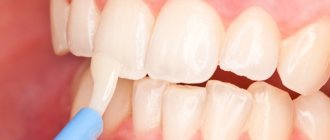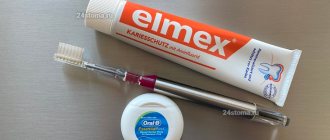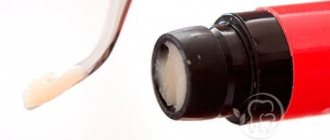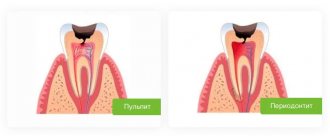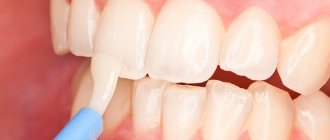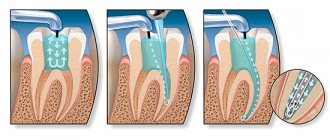To remain healthy, teeth must receive a sufficient amount of “building material” - a certain set of minerals necessary for their nutrition. Otherwise, they are affected by caries and begin to suffer from other diseases. Special dental procedures - fluoridation and saturation of teeth with calcium - help to replenish the reserves of useful minerals in case of their chronic deficiency in the enamel. It allows you to improve the appearance of your teeth, protect them from bacterial damage and premature destruction.
Fluoridation is the saturation of tooth enamel with fluoride, as well as the main minerals that form bone tissue: calcium, magnesium and others.
During the procedure, harmful bacterial flora is destroyed, fluoride ions penetrate the enamel structure. They restore and strengthen it from the inside. This provides effective prevention and treatment of caries at the stain stage, and also helps reduce tooth sensitivity.
When is remineralization indicated?
Proper nutrition and oral hygiene are very important, but not always sufficient conditions for maintaining dental health. In order for prevention to be complete, remotherapy-remineralization should be carried out regularly. This procedure gives good results in restoring enamel after whitening. It is used as a preparatory stage before bleaching, but after hygiene. Remotherapy can be clinical or home (as prescribed by a doctor).
The procedure is also indicated for:
- large-scale anti-caries therapy;
- hypersensitivity;
- after removing braces;
- pregnancy.
How is the procedure done?
Deep fluoridation
It is carried out only in a dental office using special preparations.
The procedure requires minimal preparation. It can be divided into five quick stages
:
- Teeth cleaning. Usually a special paste is used to prepare for fluoridation. But if the child has heavy plaque, another cleaning method is chosen.
- Drying the surface of the teeth.
- “Sealing” the enamel. The doctor applies a drug based on magnesium and calcium (fluorides).
- Second drying of the surface of the teeth.
- Application of the final preparation. Dental clinics use a solution of copper and calcium hydroxide.
| After the procedure, both applied layers react. All components gradually penetrate deep into the tooth, significantly enhancing its mineral structure. An important advantage of deep fluoridation is durability. Components applied to the surface are not washed out and are not affected by food or water. |
Types of fluoridation
Simple
A fairly effective way to prevent caries. A special composition is applied to the teeth in the form of a thin film, which is not felt at all and lasts up to 6 months.
Glubokoe
The method is used when the integrity of the enamel is damaged. It involves the use of compounds containing, in addition to fluorine, calcium and other minerals. Such compositions are built into the structure of tooth enamel. The effect of the procedure lasts for a year.
Before the procedure, the patient visits a hygienist. The specialist carries out a comprehensive cleaning of teeth, freeing them from bacterial plaque. This will allow the mineral ions to freely penetrate the enamel and do their work.
The procedure is carried out in three stages.
- Drying. The composition is applied to teeth dried from saliva.
- Application. The medicine is evenly distributed over the surface of the teeth, left for 5–7 minutes, after which the teeth are dried again.
- Finishing processing. To consolidate the effect, a concentrated mineral composition is applied to the teeth.
Indications and contraindications
Deep fluoridation can be carried out from early childhood (from one and a half years). Contraindications
minimum:
|
|
Indications
There is much more to applying the method:
|
|
|
|
|
|
Fluoridation of baby teeth
Failure to take your child to the dentist will lead to problems with permanent teeth. An important component of the prevention and treatment of caries in children is enamel fluoridation. The procedure can be performed for the first time at the age of 3 years. It does not cause a negative reaction in children and helps prevent the development of dental phobia in the future.
Important! The procedure is prescribed to children only after undergoing tests - excess fluoride can adversely affect the child’s health.
Why is fluoridation necessary for children?
The body in childhood experiences fluoride deficiency. The main factors influencing this are:
- Genetic predisposition.
- General condition of the body. For example, some diseases increase the lack of fluoride, and teeth weaken.
- Poor nutrition.
- Lack of normal child development.
| Due to the factors listed above, tooth enamel weakens and they become sensitive to any changes. The child feels pain when drinking cold or hot drinks or food. Without fluoride, enamel is destroyed and teeth become vulnerable to disease. If caries begins to develop in childhood, there is a high probability that by the age of 30 a person will be missing at least several teeth. Deep fluoridation is an effective preventive measure that increases the resistance of teeth to negative external influences. The risk of disease is reduced many times over. Fluoridation is especially effective when combined with proper hygiene. The child should visit the dentist regularly, use safe brushes and toothpaste recommended by the doctor. |
Fluoridation methods
There are two ways to carry out this preventive procedure. In both cases, the preparatory stage is professional teeth cleaning - this is a necessary and mandatory condition. So, fluoridation happens:
1. Simple. The procedure includes the following manipulations:
- coating of tooth enamel with fluoride varnish;
- installation of individual trays filled with a special gel.
In both cases, the time required for prophylaxis does not exceed 10-15 minutes.
2. Deep. It involves layer-by-layer application of two drugs, which provides a longer-term effect. This method requires slightly more time than in the first case.
Treating stains and protecting enamel around braces
Sometimes fluoridating teeth with Clinpro™ WhiteVarnish is not enough. For example, these are the cases:
- when, after fluoridation, the patient retains tooth sensitivity in some areas
- when caries is detected in the initial stage of the “white” spot
- when a patient is undergoing orthodontic treatment and there is a risk of white chalky spots forming around the installed braces.
In these cases, the application of Clinpro® XT Varnish is recommended. During the procedure, the doctor cleans and dries problem areas, applies material to the cleaned surface and illuminates it with a polymerization lamp.
After six months, when the effect of the drug wears off, you need to visit the dentist again. The doctor will evaluate the outcome of the treatment and, if necessary, recommend repeating the fluoridation procedure with Clinpro® XT Varnish.
DLclinic dentists recommend fluoridation of teeth only in a doctor’s office, or (for home fluoridation) after consultation with a dentist, since fluoride can be dangerous to the body in excessive concentrations. Only a doctor can determine whether fluoridation is indicated for a particular patient. Carrying out the procedure independently and uncontrolled can lead to a number of negative consequences. Consult your dentist about the benefits and method of dental fluoridation recommended in your particular case.
You can find out more detailed information and schedule a consultation through the online form.
Make an appointment
(812) 232-88-25, 233-19-08
Operating principle
The fluoridation process involves treating the surface with special-purpose preparations. A layer of a compound that releases a large amount of fluoride is applied to the enamel. Upon contact with teeth, crystalline calcium fluoride is formed, which protects against tissue destruction, calcium formation and strengthens enamel.
Deep fluoridation of teeth in children has the following advantages:
- protection of tissues from the development of caries;
- the procedure is painless and does not cause discomfort or pain to the baby;
- prevention can be started from an early age;
- unlike silvering, the enamel surface remains light and does not darken;
- tissue strength increases, excessive sensitivity disappears;
- the service life of existing fillings is extended, and the tissues are additionally protected from damage if the child wears corrective devices.
The disadvantages of performing the procedure include:
- fluoridation must be carried out regularly;
- an excess of this element is harmful to the child’s body; strengthening can be carried out only according to indications;
- In case of severe caries and a number of other damages, such manipulations are not performed.
HEALTHY “FOOD” FOR TEETH. Fluoridation of teeth.
Bodrenkova Elena
Hygienist at the Ekostom dental clinic
How effective is this technique? Is it safe? How exactly is it carried out?
There are a lot of questions, and they all require answers. The time has come to fill the gaps in knowledge, and at the same time debunk myths and dispel rumors.
Question one: why do you need fluoridation of teeth?
Most dentists will tell you that this is perhaps the only way to protect tooth enamel, prevent tooth decay (apart from good hygiene and proper nutrition, of course), and also reduce tooth sensitivity. Is it so? In what cases is the procedure effective and in what cases is it not? What does fluoridation do?
SO WHAT IS FLUORIDE?
Fluorine is a gas, and in nature it is often found in compounds with other substances: for example, calcium fluoride or sodium fluoride. Fluoride is the fluoride ion. All organic and inorganic compounds containing fluorine are fluorides, which will be discussed in this article. Fluoride is a natural element that is part of the earth's crust. Therefore, it is natural that a small dose of it (considerably less than one part per million) is contained in natural water. Plants absorb these compounds, so small amounts of fluoride are present in all our food and water, and also accumulate in animal tissue and plants.
LET'S REMEMBER A LITTLE HISTORY
The first statements that fluoride was good for teeth, as well as that it should be added to drinking water to prevent dental disease, were made by doctors Gerald Cox and Harold Hodgy. They became the main defenders of the fluoridation theory. Hoxha was responsible for numerous works in support of the water fluoridation program and its implementation by 1957.
So, what happens to the teeth, why strengthen them?
Metabolic processes constantly occur in teeth. Many people have probably heard more than once about such a phenomenon as the acid-base balance, which must be restored every time after eating. This is explained by the fact that after eating, the pH of the oral cavity becomes acidic. To neutralize this condition, the process of “washing out” microelements from tooth enamel into the oral cavity is activated. This process is called demineralization. If it becomes dominant over the processes of remineralization, then defects appear in the enamel, which subsequently open the way for the development of caries. This is a pathological process in which the hard tissues of the teeth are destroyed. The result is increased tooth sensitivity, caries, and periodontal disease.
Fortunately, modern medicine offers many ways to maintain healthy teeth and restore their natural beauty. One such method is remineralization therapy.
So, let's start step by step. As with any procedure, there are indications and contraindications. The procedure for dental fluoridation is a responsible undertaking. It cannot be done according to your “wish”; the need for fluoridation is determined by a specialist.
Fluoridation of teeth is prescribed:
• to strengthen tooth enamel;
• for the prevention of caries (primary, secondary, in the spot stage);
• to eliminate tooth sensitivity;
• to extend the service life of existing fillings;
• after teeth whitening;
• after removing braces or splinting structures;
• with a genetic predisposition to an imbalance of minerals.
Contraindications to fluoridation:
• increased fluoride content in drinking water;
• allergy to fluoride preparations;
• fluorosis (damage to enamel due to consumption of large amounts of fluoride since childhood).
PREPARATION FOR THE PROCEDURE
Before fluoridation of teeth, dentists recommend: undergoing professional oral hygiene; cure caries and other diseases of the oral cavity, fill non-carious defects.
There are two types of dental fluoridation: simple and deep.
And now in more detail about each method.
SIMPLE FLUORIDATION OF TEETH
This effective and painless method is most common in dental practice. According to reviews of the procedure, some patients experience positive results with tooth sensitivity almost instantly.
So, the first method is the use of individual mouthguards or, as the doctors themselves call them, “spoons.” At your first appointment, your doctor will make a wax impression of your teeth or use standard aligners. The recesses are filled with a special fluoride-containing preparation (usually a gel for fluoridation of teeth). The mouth guard is placed on the teeth for 10-15 minutes. The number of procedures is from 1 to 10.
The second method uses not a gel, but a special varnish. It must be applied to the enamel of the teeth with a brush, being careful not to get on the gums and mucous membranes. Number of procedures - 3-4. The peculiarity of simple fluoridation of teeth is that during this procedure, fluoride does not penetrate deeply, but creates a protective film on the surface of the enamel. Such protection usually lasts for six months. Then the procedure is repeated.
DEEP FLUORIDATION OF TEETH
Deep fluoridation of teeth is a more complex procedure, but also more effective. Here enamel-sealing preparations are used. To be more precise, there are two of them. The first preparation contains copper, magnesium and fluorine, and the second contains calcium hydroxide. Both substances are applied alternately to the teeth. If we omit the chemical terms, we can say that when these drugs interact, tiny crystals are formed that fall into the pores of the enamel and seal them. Now your teeth are protected from negative external influences.
Very often patients ask the question: is the procedure possible at home?
You can do remineralization at home in an additional course. Semi-professional gels with fluoride Elmex, ROCS Medical Minerals, Tooth Mousse are suitable for this. The use of these drugs will strengthen the enamel, improve the shine and color of teeth without the help of aggressive whitening agents, which is especially important for those patients for whom the whitening procedure is contraindicated. These products are not dangerous if accidentally swallowed and have no age restrictions. It is recommended to use them in 2-4 week courses.
IN CUSTODY
Remineralizing therapy is usually carried out in courses. Depending on the condition of the teeth, the specialist will prescribe procedures for adults and children. During the fluoridation process, harmful bacteria on the surface of the teeth are first destroyed, and then the drug penetrates deep into the enamel and seals it, providing protection from the destructive effects of acids and other negative factors.
To summarize: remineralization therapy is a truly effective method for preventing caries in the initial stages. It is able to compensate for the loss of minerals in tooth enamel, increasing its resistance.
This method is completely painless, aimed at preserving the beauty and health of your teeth.
Prevention is better than cure. Therefore, instead of sitting and waiting for your teeth to be “eaten” by caries, try dental fluoridation.
Advantages of fluoridation compared to silver plating
Previously, silver plating was used as a preventative measure. But most leading dental clinics abandoned it in favor of deep fluoridation. Here are the reasons:
|
Dentists speak flatteringly about the deep fluoridation procedure. In an interview with the newspaper “Arguments and Facts”, maxillofacial surgeon David Grigoryan Fr.
You can carry out deep fluoridation at our Nikadent clinic in Mytishchi. The cost of the service is quite affordable - about 2.5 thousand rubles. This price includes: professional consultation, preparation, cleaning of tartar, drying of teeth, application of fluoride.
